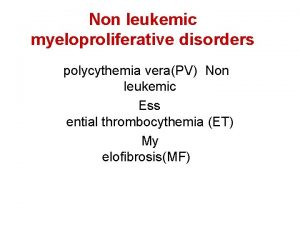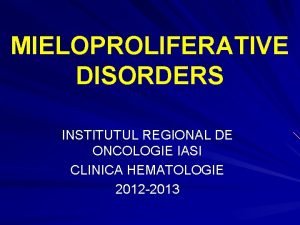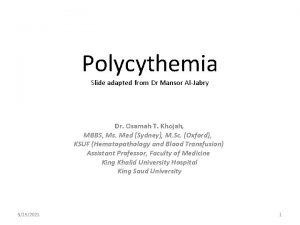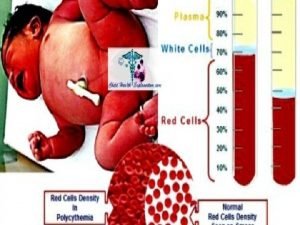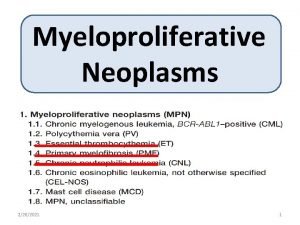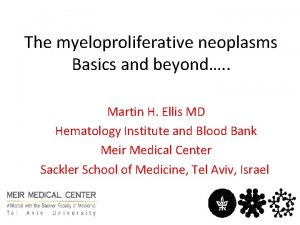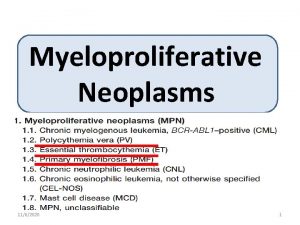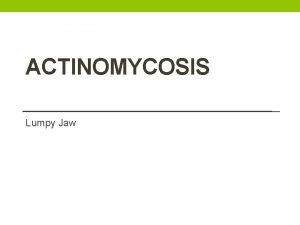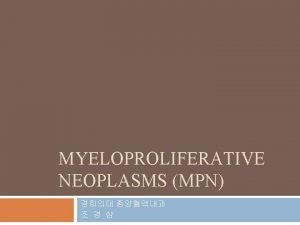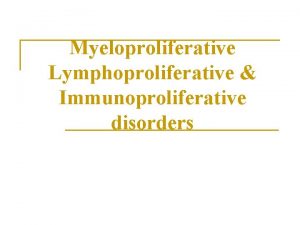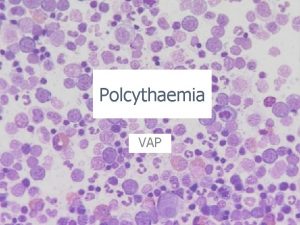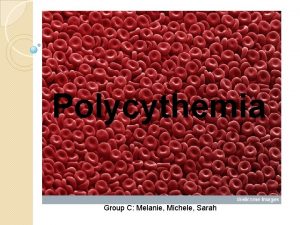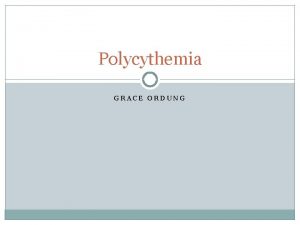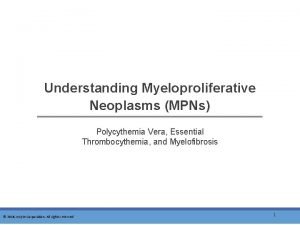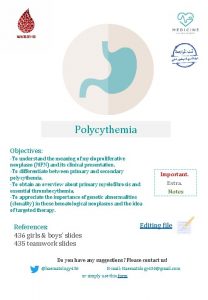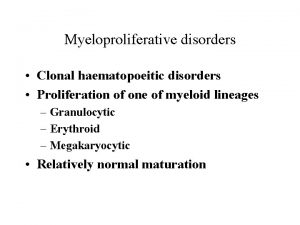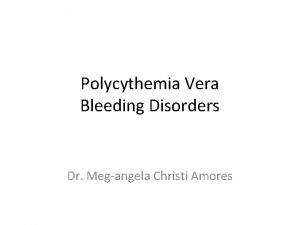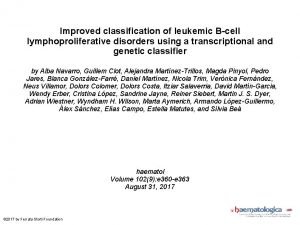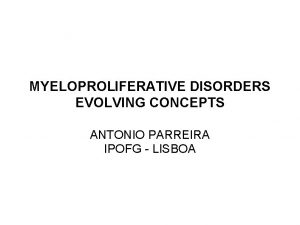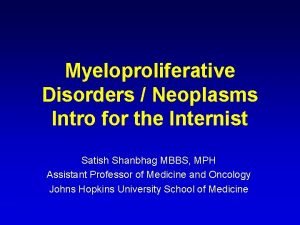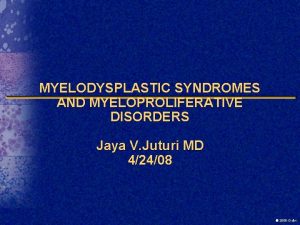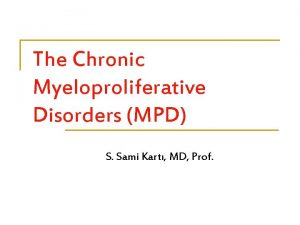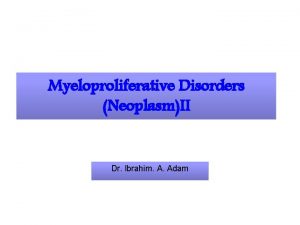Non leukemic myeloproliferative disorders polycythemia veraPV Non leukemic





















- Slides: 21

Non leukemic myeloproliferative disorders polycythemia vera(PV) Non leukemic Ess ential thrombocythemia (ET) My elofibrosis(MF)

myeloproliferative disorders(MPD) a group of conditions characterized by clonal proliferation of one or more haemopoietic components in the BM & in many cases in the liver & spleen. These disorders are closely related to each other , transitional forms occur & in many cases an evolution from one entity into other occurs during the course of disease.

polycythemia vera(PV), polycythemia rubra vera(PRV) blood changes includes an increased haemoglobin above 17. 5 g/dl in adult males & 15. 5 g/dl in females usually with increased red cell count above 6× 109 /l in male & 5. 5× 109 /l in females & haematocrit above 55% in males & 47% in females. The increased in red cell volume is caused by endogenous myeloproliferation due to stem cell defect, so in many patients overproduction of granulocytes & platelets occur as well as of red cells.

Causes of polycythemia:

Clinical features: This disease is of old subjects with equal sex incidence & the clinical features are the result of hyperviscosity, hypervolaemia or hypermetabolism. 1 -Headach, pruritis (especially after hot path) , dyspnoea, blurred vision & night sweat. 2 - Plethoric appearance – ruddy cyanosis. 3 - Splenomegaly in 2/3 of patients. 4 -Haemorrhage or thrombosis ( either arterial or venous ). 5 - Hypertension in 1/3 of patients. 6 - Gout due to raised uric acid production 7 - Peptic ulceration in 5 -10%.

Lab. Findings: 1 -The haemoglobin, haematocrit, red cell count & total red cell volume are increased. 2 -Neutrophil leucocytosis is seen in 1/2 0 f cases. 3 -Raised platelets count in 1/2 of cases. 4 - The neutrophil alkaline phosphatase score is high. 5 - Increased serum B 12 & B 12 binding capacity because of increased transcobalamin 1 6 - BM: is hypercellular with prominent megakaryocytes. 7 -Blood viscosity is increased. 8 - Plasma urate is often increased. 9 - Circulating erythroid progenitors are increased & grow in vitro independently of erythropoietin.

Essential thrombocythaemia (ET), primary thrombocythaemia Megakaryocyte proliferation & overproduction of platelets count above normal , this condition is closely related to PRV. Some cases show patchy fibrosis.

Criteria for diagnosis of ET: Platelets >600× 109 /L No evidence or indication of raised red cell mass No Philadelphia chromosome or bcr-abl rearrangement No support for a diagnosis of MF No demonstrated cause for reactive thrombocytosis

Clinical features: 1 -Recurrent hemorrhage & thrombosis 2 - splenic enlargement in early phase but splenic atrophy due to platelets blocking the splenic microcirculation 3 - There may be anemia (due to iron deficiency anemia from chronic bleeding) or polycythaemia Lab. Findings: 1 -Abnormal large platelets & megakaryocyte fragments may be seen in peripheral blood film 2 -The BM is similar to that in PRV 3 -Cytogenetic are analyzed to exclude CML 4 -Platelet function tests are constantly abnormal ( Failure of aggregation with adrenaline)

Myelofibrosis(MF) Pathogenesis: Generalized haemopoietic stem cells proliferation with splenic & hepatic involvement in which there is extramedullary haemopoiesis , there is reactive fibrosis in BM secondary to hyperplasia of abnormal megakaryocytes. There is stimulation of fibroblast probably by platelet-derived growth factor secreted by megakaryocytes & platelets & inhibition of collagenase by platelet factor IV.

Clinical features 1 - 1/3 of patients has previous history of PRV & some times present with features of both disorders. 2 - An insidious onset in older people is usual with symptoms of anemia 3 -Symptoms due to massive splenomegaly 4 - loss of weight, anorexia & night sweats are common. Bleeding problems, bone pain, gout occur in minority of patients.

Lab. Findings: 1 -Anemia is usual but normal or increased hemoglobin may be found in some patients. 2 - The WBCs & platelets count are frequently high at the time of presentation, later in disease leucopenia & thrombocytopenia are common 3 - A leuco-erythroblastic blood film is found. The red cells show characteristic tear drop shape. 4 - BM is usually not obtainable by aspiration. Trephine biopsy may show hyper cellular marrow with increased reticulin-fiber pattern.

Other causes of marrow fibrosis: 1 -CML 6 - Metastatic carcinoma 2 - AML FAB 7 7 - Non-Hodgkin's lymphoma 3 -MDS 8 --Hodgkin's disease 4 - myeloma 9 - Tuberculosis 5 - Hairy cell leukemia 10 - Leishmaniasis

Multiple myeloma(MM) Is neoplastic monoclonal proliferation of BM plasma cells. Characterized by lytic bone lesion, plasma cell , accumulation in BM & presence of monoclonal protein in serum & urine. 98% of cases over the age of 40, with peak incidence in the 7 th decade

Clinical features 1 - Bone pain, pathological fracture. 2 - Features of anemia. 3 - Repeated infections because of deficient Ab & later on because neutropenia. 4 -features of renal failure & /or hypercalcaemia. 5 - Abnormal bleeding tendency because myeloma protein interfere with platelets function & coagulation factors & later on because of thrombocytopenia. 6 - Occasionally macroglossia , carpal tunnel syndrome, diarrhea due to amyloid disease 7 - In 2% hyperviscosity syndrome.

Diagnosis ( Lab. Findings) : This depends on 3 principle findings 1 - In 98% of patients monoclonal protein occurs in the serum or urine or both. The serum paraprotein is Ig. G in 2/3 of cases. The urine contain Bence-Jones protein in 2/3 of cases which is free light chains ( κ or λ) of the same type of serum paraprotein 2 - BM shows increased plasma cells > 4% & usually > 30% often with abnormal form ( myeloma cells) , these cells are monoclonal B cells & express the same Ig heavy & light chain of serum monoclonal protein


3 - Skeletal survey shows osteolytic areas without evidence of surrounding ostublastic reaction. Usually at least 2 of the 3 diagnostic features mentioned above are present.

Other lab. Findings: 1 -Normochromic , normocytic anemia. Rouleaux formation is marked in most cases. Neutropenia & Thrombocytopenia in advanced cases. Plasma cell seen in blood film in 15 % of cases. Leucoerythroblastic picture occasionally seen. 2 - High ESR( Erythrocyte sedimentation rate. ) 3 - Serum calcium increased in 45% of patients. 4 -Blood urea & serum creatinine increased in 20% if cases. 5 - Low serum albumin occurs in advanced disease.


Plasma cell leukaemia: This occurs either as a late complication of myeloma disease or often in younger patients as a primary disease characterized by the presence of 20% or more plasma cells in the blood, with an absolute count of>2× 109/L. There is more liver & spleen involvement than in myeloma, the paraprotein concentration in serum is often low. The results therapy is poor.
 Myeloproliferative disorders
Myeloproliferative disorders Verapv
Verapv Polycythemia differential diagnosis
Polycythemia differential diagnosis Polycythemia vera dogs
Polycythemia vera dogs Erythrocytosis vs polycythemia
Erythrocytosis vs polycythemia Megaloblastic anemia laboratory findings
Megaloblastic anemia laboratory findings Polycythemia vera diagnostic criteria 2021
Polycythemia vera diagnostic criteria 2021 Polycythemia causes
Polycythemia causes Myeloproliferative neoplams
Myeloproliferative neoplams Polycythemia
Polycythemia Myeloproliferative disease
Myeloproliferative disease Myeloproliferative disorder
Myeloproliferative disorder Myeloproliferative neoplasm
Myeloproliferative neoplasm Polychromasia
Polychromasia Liters to gallon
Liters to gallon Lichen sclerosus vulvare
Lichen sclerosus vulvare Toc toc quelqu'un frappe à ma porte
Toc toc quelqu'un frappe à ma porte Nursing management of sleep disorders
Nursing management of sleep disorders Acid base disorders chart
Acid base disorders chart Seborrheic keratoses
Seborrheic keratoses Cluster b personality traits
Cluster b personality traits Cluster b personality disorders
Cluster b personality disorders

